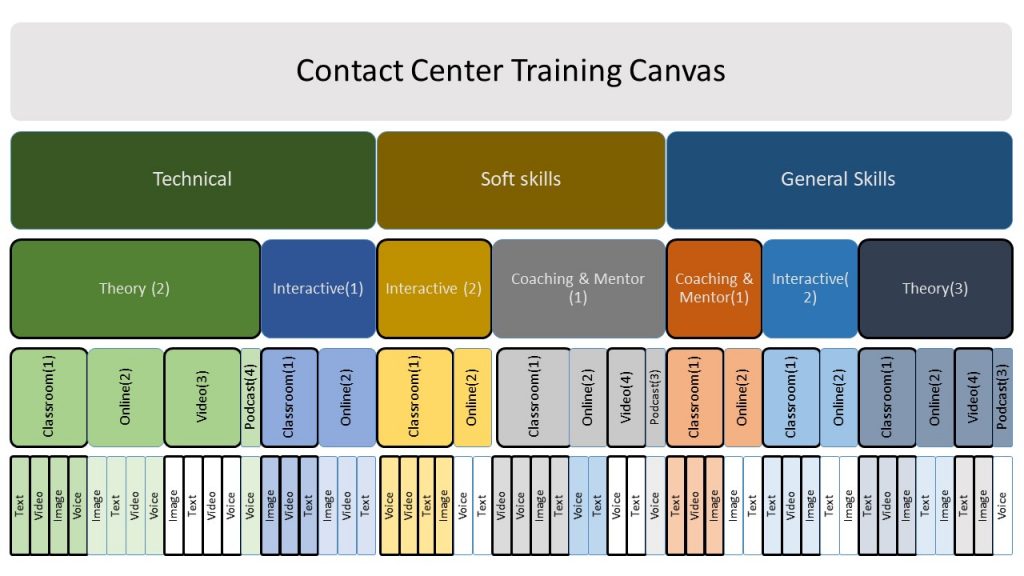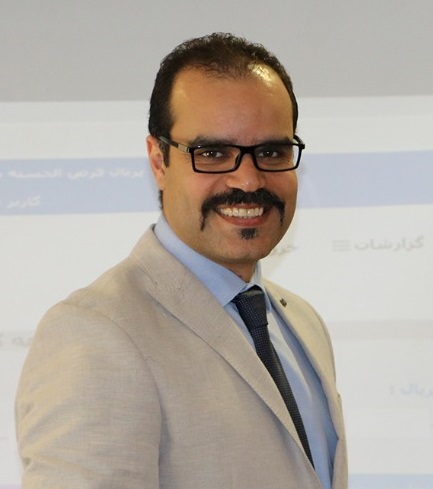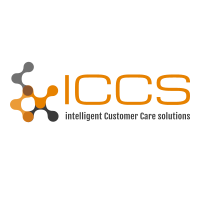We want to talk to you for a few minutes about training in call centers and share some content with you.
As you know, service-oriented organizations are organizations in which the customer plays the role of the main decision-making element and the organization’s processes are designed based on increasing customer retention in the organization. Because these organizations believe that their main asset is their customers who have spent a lot of money to obtain it and try to maintain this asset in the best possible way.
In this slide, we talk a little about the levels of customer-centric organizations and the depth of their relationship with their customers.
Note that all three levels of “service orientation” are for organizations that have at least some of this culture within their organizations, and many organizations probably do not fall into this category.
As you can see, 3 levels are seen in the process of organizational development in “customer-centric”.
At the first level, organizations try to be polite in relation to customers and provide the right guidance of the organization’s processes to customers so that they can better and more easily follow up and solve their requests from the organization. At this level, Contact centers have a guiding role and do not play a very important role in solving the audience’s problems, but they try to give the audience a good sense of communication with the organization with appropriate behavior.
in The second level, Agents and staff of the Contact Center have good knowledge and skills of the organization’s products and services, and also have a thorough knowledge of work processes and they can, help to solve audience problems and follow up issues in organization, like an expert .
At this level, communication with customers is much deeper and takes place as a co-worker, creating a lasting relationship.
In the third stage, which is a very advanced and rare stage, the organization plays the role of a friend for the customer and tries to fully think about the customer’s interests and have action plans in this regard. Takes action before announcing the customer and even does things beyond its obligations to customers. At this stage, the organization and the customer are completely combined and it will be very difficult to separate them.

ustomer-oriented behaviors in the organization are influenced by 3 main pillars
Staff
Tools
Philosophy of organization
“Customer oriented behavior” originates from the philosophy of the organization, which manifests itself in the strategies and processes of the organization and, of course, the dominant culture of the organization. In this regard, the senior managers of the organization and their behaviors and decisions are very decisive
Tools can play a huge role in the implementation of organizational programs and the quality of implementation of those programs. The speed and ease of implementing customer service processes is very effective in creating the right experience for customers, and technological tools can help a lot. Choosing the right tools is very important
But all of the issues raised in the staff’s behavior with customers are reflected, which of course the front line staffs are more effective. Call centers are perhaps the main place where customers interact with the organization and the manifestation of all our processes and strategies in the field of customer service can be seen in call centers. It can be said that call centers are a summary of the organization

In evaluating and upgrading the organization’s staff, we need to look at four key areas •Knowledge: “Knowledge” means a set of information that a person has acquired through education, study, experience and other ways of receiving information and can remember and to some extent analyze it. •Skills: “Skills” refers to the ability to apply knowledge in a practical and good quality manner at work, which is again enhanced through continuous training and on-the-job experiences. •Abilities: or the talent of individuals that must be evaluated at the beginning of the work and change it is either impossible or very expensive and costly and has no justification for the organization except in special cases •Motivation: Motivation of people is influenced by many factors and motivating factors or reducing factors of motivation vary according to the personality of individuals and also the period of their lives that must be evaluated so that we can use appropriate stimuli to motivate individuals. •At least 4 to 5 percent of staff time in the call center should be spent on training, and training is one of the main factors motivating and keeping staff in the organization.

In this slide you will see 4 main items in each of the items mentioned.
These are items that should be considered by call center staff and try to improve them in your training.
Adequate knowledge and information of service principles as well as practical skills and related techniques.
Adequate knowledge about telecommunications and computers, because the main tools used in the call center are based on telecommunications and computer equipment, and sufficient knowledge of this equipment is very effective in increasing the efficiency of personnel.
As you can see, the main skill required in the call center is active listening skills, which are even more important than speaking skills.
In this discussion, I do not want to talk about these in detail, I just wanted to show that call center training should be planned with the goal of improving these items, and the importance of training and training psychology is very important for each of these skills.

The main goal of training in any organization is to create appropriate behavior with the culture and goals of the organization and all the things you saw in the previous slide, regarding knowledge, skills and abilities should lead to creating these 4 behaviors in staff and transferring value to your customers in the call center. To be able to say that the organization has customer-oriented behaviors 1.Empathy 2.Active Listening 3.Proactivity 4.Patience
If our training in the call center leads to these 4 main behaviors in experts, it shows that our training is on the right track and we have been able to plan and implement effective training.

The training process in the call center for the staff of the call center starts from the first day and continues until the last days of presence in the call center and is a continuous activity, so it is very important that this process from the beginning and by choosing the right person and identify the right training methods for staff to avoid wasting the time and resources of the organization.
Call center training, which includes hiring time training and on-the-job training, is usually assessed through evaluations and feedback to determine if it has been effective.
Call center training is either long-term training or short feedback given in the coaching process.
It is very important in training plan to pay attention to the teacher’s methods and the learner’s style so that we can be most effective.
Certainly a consistent training method will not have the same result for all training topics and for all personnel.

There are 4 influential elements as a result of the training program that we must pay attention to in order to be able to achieve the desired impact.
Trainer : Someone who is supposed to teach content or skills to call center staff at any level
Learner or trainees : All call center staff who are trained in knowledge or skills
Content transfer media: The media through which the trainer transmits the educational content to the learner
Workplace: a place where the trainer and the learner are connected to perform the training program
These 4 elements should be considered in your training program and should be considered in accordance with the items that we will talk about in the following, in order to have a greater impact on training and your trainees to become a behavior in your staff

In this section, we review 3 common training models in organizations and see what each of them has strengths and weaknesses.
Note that we are talking about training in call centers and in call centers we need that the taught content has become a skill or if it is just knowledge, the learner can use this knowledge in the shortest possible time while working
Theory model: In this model, which has been very common, the trainer’s focus is on transferring theoretical knowledge through pamphlets and books, and the trainer has a lot of focus on the correct transfer of teaching content, and generally the classroom space is more one-sided and learners themselves need do more activities about the content provided so that the transferred knowledge becomes a skill
As you can see in the picture, a lot of content is presented in the theory model and generally in a categorized form, but the main disadvantage of this model is that the content is boring and sometimes unusable.
Interactive model: In the interactive model, the trainer tries to involve the learners more in the training process and chooses an interactive method for conveying the content. In the interactive training method, there is usually a lot of energy between the trainer and the learner, and the classroom atmosphere is very fun. Content is conveyed in the interaction between people and has more influence on the learner, but due to the type of teaching, less content may be conveyed and less structured.
Coaching and mentoring model: In the coaching model, the teacher becomes an instructor and transfers the educational content to the learner at a time with a combination of different training models, and of course, leaves a part of it to the learner and guides and controls the process. Training helps the learner to have a deeper understanding of the content being taught.
As you can see in the diagram, if we compare these three methods in terms of time and effectiveness, the theoretical method has a high time and less impact, the interactive method has less time and relatively higher impact, and the coaching method has a highest time but deeper impact.
Note that a trainer can use a combination of training methods, and certainly the choice of teaching model depends on factors such as time, budget and of course educational facilities.

Certainly you have noticed throughout your life that when you come across a fixed educational content in different forms, your learning rate is different. It depends on your learning model and it is definitely different in different people.
The first 4 models, ie visual, auditory, reading/written and Kinesthetic
models, are the main models and the other 3 models originate from them.
You can identify your staff learning model using the VARK Model Questionnaire.
Visual model: Visual learners perceive by seeing and gain understanding of new concepts through images and spatial relationships of objects. Workplace training for visual learners should include demonstrations with numerous charts, videos, and diagrams.
Auditory model: Auditory learners are excellent listeners and use different patterns in teaching and speaking. This type of learner prefers speech and audio recording, which gives them many opportunities to talk and listen.
Reading and writing model: These people have the best learning by carefully reviewing the text, reports, stories and case studies. Workplace training for this type of learners can include manuals, booklets, tests and lectures.
Kinesthetic model: Kinesthetic learners expand their understanding of new information through their senses and enjoy activities such as simulations, visits, and sessions that involve practical work or working with objects.
Logical model: These people, sometimes called as math learners, learn by studying whole systems, patterns, and high-level concepts. They focus in particular on holistic methods, multi-step methodologies, and graphs. Logical learners respond well to on-the-job training, which includes opportunities to combine several great concepts into one great idea and shows them how they can improve their behavior.
Social Model: These learners are strong in understanding the feelings and motivations of others. Their presence promotes team learning activities, role-playing and group discussion.
Solitary model: Individual learners, as the main method of combining and creating a sense of learning, pay attention to self-reflection and introversion. Learning for this model Learners should include opportunities to work with content as well as balancing collaborative activities with things that allow them to work independently.

By examining training models and learning models, we want to examine the other two main elements, the place of training and the medium of content transfer, so that we can finally reach the Call center training canvas .
The workplace of training in call centers is a space in which educational content is transmitted from the Trainer to the learner by the Content media.
The spaces used in call centers can be training classrooms, video training equipment, online training and podcasts that Trainers can use.
Content media: The media used through which and in the educational space used, educational content is transmitted to the learner
Note that the training place is the space and equipment used for training, and the media is the form of content delivery to the learner. For example, video equipment should be used to hold and record a training course in the classroom, but in the media, video media means playing educational clips related to the subject of teaching.

Given that the call center staff are generally young and from the Z generation, experience shows that the media of this generation is more visual and more welcome video and photos.
But according to the review of learning models in this slide, I will show you which media are more convenient for each of the learning models and have the greatest impact on them.
Text : This medium is naturally the best medium for the Reading/writing learning model, but it can definitely be very helpful for visual, logical and Solitary learning models.
But keep in mind that this medium is used in almost all models of training and certainly all models of learning are faced with it, but the extent of its use and effectiveness is different.
Image: This media alone can not meet all the needs of your content transfer, but it is a great complement to text and video media, and the use of this media can make media such as text more attractive to the group of learners who need to see more.
Video: This medium is very effective and greatly increases the retention of content in the mind of the audience, and of course in times when it is necessary to teach a practical skill or show the work environment can be very helpful.
Podcast: This medium is certainly a very helpful medium for conveying short and simple concepts, but it is definitely not suitable for conveying long and complex content. This content can have a greater impact on auditory, social and Solitary learners.
Certainly, the combined and parallel use of all these media can greatly increase the effectiveness of training in the correct transmission of training content to call center staff in whom the diversity of learning may be high.

•The contact center training canvas shows us what kind of training is most effective in the educational content of the contact center, which workplace and through what content Media •
Tips to know about this canvas
1- The cases proposed in this canvas are based on experiences and the law is not final
2- In each block where there is a number, it indicates priority (1 has the highest priority) •

There are usually three types of training in call centers
Product technical training that call center personnel must provide for that product
Call center soft skills training that includes specialized skills and techniques of the call center industry
General job training related to common work and management skills
Each of these trainings is better than being held in a suitable educational space and using more effective media
For example, call center soft skills are best taught in a Coaching and interactive way in the classroom, and of course almost all media can be helpful, but video and image media is more effective.
This call center training canvas helps you choose the most effective way to train your staff
Keep in mind that the most important element influencing the integration of training is the hiring and retention process.
I hope this presentation was useful for you and you can improve your training process.

Ali Ghanadian
LinkedIn Profile


Comments are closed